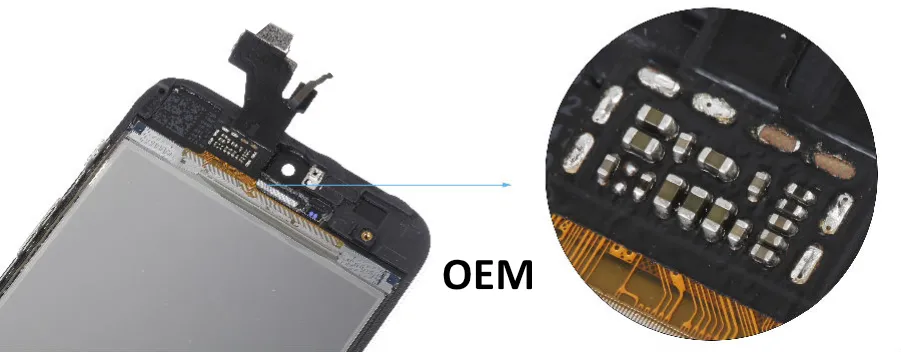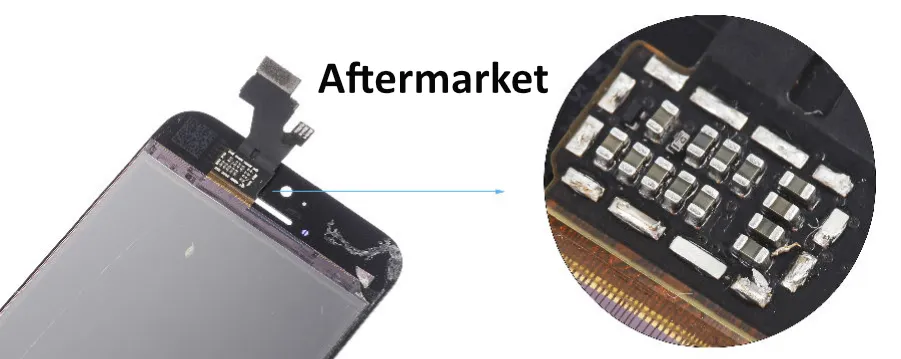Difference Between OEM and Aftermarket Screens
Difference Between OEM and Aftermarket Screens
When a phone screen breaks, the first thing that comes to mind is replacement. But when you go for a screen replacement, you’ll often hear two terms, OEM and Aftermarket. If you don’t know what these mean, it can be hard to make the right choice.

What Is an OEM Screen?
OEM stands for Original Equipment Manufacturer. An OEM screen is the same type of screen that your device originally came with. It is either made by the brand itself or by a manufacturer that supplies parts directly to the brand.
For example, if you use an iPhone, the screen that comes with the phone is OEM. If your screen breaks and you replace it with another screen of the same quality and from the same source, then that’s also an OEM screen.
It fits perfectly, works exactly like the original and gives you the same display, brightness and touch experience.
What Is an Aftermarket Screen?
An Aftermarket screen is made by a third-party manufacturer. It is not approved or supplied by the original brand. These screens are designed to be compatible with your device but may differ in quality.
Some Aftermarket screens look just like the original, while others feel and perform differently. They are often cheaper, which makes them a popular choice for budget-conscious users.
However, the quality depends on the company that makes it. There are good Aftermarket options, but there are also poor ones that might affect the phone’s performance.

Main Difference Between OEM and Aftermarket Screens
Let’s break down the difference between OEM and Aftermarket screens into key areas. This will help you understand which option suits your needs.
1. Quality and Materials
- OEM Screens use high-quality glass, display panels and adhesives. Every part is tested before it reaches you.
- Aftermarket Screens can vary. Some use good materials, but many are made with cheaper components to reduce cost.
OEM screens usually feel smooth and strong. Colors appear bright and natural. In contrast, some Aftermarket screens may look dull or feel slightly different when you touch them.
2. Display and Touch Response
- OEM screens offer clear visuals, accurate colors and quick touch response. They are built to work perfectly with your device.
- Aftermarket screens may not show the same sharpness or color accuracy. Touch sensitivity can also be slower or less precise.
For gamers or those who watch a lot of videos, this makes a big difference.
3. Durability and Lifespan
- OEM screens are long-lasting. They are designed to handle regular wear and tear.
- Aftermarket screens might not last as long, especially if made with cheap materials.
Some users find that Aftermarket screens start fading or stop working properly after a few months. This depends on the quality of the screen and how carefully the phone is used.
4. Price and Affordability
- OEM screens are more expensive because of their quality and brand assurance.
- Aftermarket screens are cheaper. You can save money, especially if the phone is old or not used daily.
The price is one of the main reasons people choose Aftermarket screens. If your phone is out of warranty, this can be a cost-effective choice.
5. Availability
- OEM screens are sometimes hard to find, especially for older devices.
- Aftermarket screens are widely available, both online and in local repair shops.
Need help sourcing a screen? You can visit a trusted repair center, such as BC Electronics Repair, which offers screen replacements and other device repairs.
6. Warranty and Support
- OEM screen replacements often come with a warranty if installed by an authorized service center.
- Aftermarket screens may not have a warranty or support. Some sellers offer limited guarantees, but not all.
If peace of mind matters to you, OEM screens are a better choice.
Pros and Cons of OEM Screens
Pros:
- Original quality and perfect fit
- Excellent display and touch
- Long-lasting performance
- Comes with a warranty (in most cases)
Cons:
- High cost
- Limited availability for old models
- May only be installed by authorized service centers
Pros and Cons of Aftermarket Screens
Pros:
- Affordable
- Easy to find
- Good enough for basic use
- Useful for older or backup devices
Cons:
- Mixed quality
- Shorter life span
- May not fit perfectly
- No official warranty in many cases
Which One Should You Choose?
The difference between OEM and Aftermarket screens depends on what you need and what you’re willing to spend.
Choose an OEM Screen if:
- Your phone is new or valuable
- You want the best quality
- You use the device daily for work or entertainment
- You want peace of mind with warranty
Choose an Aftermarket Screen if:
- You have a limited budget
- Your phone is old or a backup
- You can accept minor differences in display or touch
- OEM parts are unavailable
How to Know If a Screen Is OEM or Aftermarket
If you’re unsure whether the screen is original or not, try these tips:
- Ask clearly: A good shop will tell you if the part is OEM or Aftermarket.
- Check the packaging: OEM parts often come in branded boxes.
- Look at the price: If it’s too cheap, it’s probably not OEM.
- Test the screen: Before paying, check the brightness, colors and touch.
Trustworthy repair centers are more likely to offer honest answers and better quality.
Common Myths
Let’s clear up a few misunderstandings:
- Myth 1: All Aftermarket screens are poor
Truth: Some are actually very good. You just need to pick the right supplier. - Myth 2: You can only get OEM parts from the brand store
Truth: Some independent repair centers also offer OEM parts. - Myth 3: Aftermarket screens ruin your phone
Truth: If the screen is of decent quality and installed properly, it won’t harm your phone.
Conclusion
The difference between OEM and Aftermarket screens is more than just cost. It’s about quality, usage, and what matters most to you. OEM screens are the best choice for those who want performance and peace of mind. Aftermarket screens are great for saving money and getting a quick fix.
Whatever you choose, ensure that you have your screen replaced by experts who genuinely care about your device. If you’re in Canada or nearby, BC Electronics Repair is a reliable choice. They help you make the right call without pressure, just honest advice and good service.
